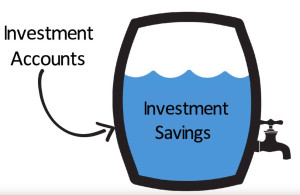 For virtually my entire career, bond yields have been characterized as “historically low” – yet have fallen with few interruptions. Since the Financial Crisis, however, yields have been super skinny and have continued falling. Razor thin yields challenge traditional balanced portfolios (which I wrote about in this 2012 blog post). So many are dumping some or all of their bonds for higher-yielding and higher-returning investments.
For virtually my entire career, bond yields have been characterized as “historically low” – yet have fallen with few interruptions. Since the Financial Crisis, however, yields have been super skinny and have continued falling. Razor thin yields challenge traditional balanced portfolios (which I wrote about in this 2012 blog post). So many are dumping some or all of their bonds for higher-yielding and higher-returning investments.
But investors have been adding this extra yield (and total return) in exchange for increased exposure to stocks and treating them as bond replacements because of the associated income. Many have enjoyed the upside of this strategy but are likely unaware of the risk this involves.
When (not if) the next bear market occurs, don’t expect these riskier bond replacements to offer any protection. Here are some popular investments or strategies that many have used as bond substitutes:
Dividend-Paying Stocks and REITs
The lure of equities paying a “steady stream of growing income” is understandable. Real estate investment trusts (REITs) and dividend-paying stocks offer attractive yields and the potential for rising payouts.
But there are three problems with using them to replace bonds:
- In bear markets, both dividend-paying stocks and REITs are likely to suffer as much as the broader stock market. They almost never protect against bear markets because they’re likely to get swept up in the doom-and-gloom just like other stocks. *See the accompanying table for some selected supporting statistics.
- While both dividend-payers and REITs have outperformed broader markets over the past 20 years, the tailwind of falling interest rates has been a big factor. I expect that they’ll perform fine in the face of rising rates but the extra return potential of the past is far from a sure thing in the future.
- Investors assume that they’ll be able to hold onto their income-producing equities better than other stocks because of the continued income flow. If dividends are paid in cash (i.e. not reinvested) price declines will be even steeper in bear markets than many realize. Take the S&P/TSX Capped REIT Index as an example.
The returns shown in the below table are total returns – i.e. they assume that all dividends are fully reinvested in the same index. And when dividends are not reinvested, the share price decline is more severe in bear markets. The table shows that the REIT Index dropped by 51.5% on a total return basis during the last bear market. But investors taking the dividends in cash would have seen the price drop by more than 62% over 2+ years.
Think of watching your “capital” drop for two years; seeing every dollar drop to less than 38 cents. How do you know that it won’t drop further? How do you stop yourself from selling out of fear that it will keep falling? The REIT index took more than 4 additional years for the price to climb back to its previous peak. That’s more than 6 years under water. Admittedly this kind of decline doesn’t happen often. But it will again at some point. And when it does, it will test all but the most disciplined investors.
The table below shows risk and return statistics for three types of Canadian equities – alongside HighView’s 60/40 balanced portfolio model. Our balanced model shows a significantly lower total return compared to being 100% invested in stocks – not surprising given that it’s 40% invested in bonds. But some of our model’s solid risk and return stats are also attributable to our selection of managers and the design of the mandates used to build client portfolios.
| Nov-2002 through Feb-2017 | Canadian Stocks | Canadian Dividend Payers / Income Trusts | Canadian REITs | HighView 60/40 Balanced Portfolio Model |
|---|---|---|---|---|
| Annualized Return | 9.3% | 11.6% | 10.6% | 7.3% |
| Best Year | 47.6% | 66.0% | 75.6% | 25.8% |
| Worst Year | –38.2% | –36.0% | –39.9% | –13.5% |
| % of Losing Years | 23.0% | 24.2% | 25.5% | 14.3% |
| Biggest Drop | –43.3% | –46.7% | –51.5% | –16.7% |
| Time Under Water | 31 months | 28 months | 43 months | 27 months |
| Standard Deviation | 12.3% | 14.0% | 14.1% | 7.2% |
*Please see the important disclaimer at the bottom of this post.
Covered-Call Strategies
Holding stocks and selling options against those stocks is another strategy some investors use to replace the income they once received from bonds. But this is even worse than income-paying equities since the strategy offers more exposure to the market’s down moves than it does when the market is leaping higher. (See this September 2012 blog post for more on this strategy.)
Bonds Have a Role to Play
We build portfolios for clients using building blocks made up of exposure to stocks, bonds, cash, and private market assets. Each building block has a defined purpose or role to play in pushing clients closer to their goals over time. While we expect stocks to outperform bonds over the next decade; even low-yielding bonds have a role to play.
They offer clients a stable – albeit low – income stream. Bonds also offer stability since they tend to perform well when stocks fall hard. And that makes them a source of cash to rebalance when it’s most important. So if you’re looking for alternatives to your bonds, make sure your decisions are made in this kind of purpose-driven context.
HighView is an experienced investment counselling firm for affluent Canadian families and foundations. Schedule a complimentary discovery session to see if we’re the right team for you.
Watch our video: “Legitimate Yield… or a Mirage of Cash Flow”.
You may also be interested in:
- What the 2017 Federal Budget Means for High Net Worth Canadians
- What Is Wealth Stewardship?
- Concerns with “Fund Facts” and “ETF Facts” Risk Ratings
Disclaimer
HighView Financial Group is a brand name used by HighView Asset Management Ltd. (“HighView”). HighView is an experienced boutique investment counselling firm, dedicated to developing sustainable wealth solutions customized to our clients’ specific needs and goals. HighView is registered in Ontario, British Columbia, Alberta and Saskatchewan in the category of Portfolio Manager.
Unless otherwise noted, portfolio performance is for periods ending February 28, 2017 using quarterly returns and are net of expected management, advisory, custody fees and applicable taxes unless otherwise noted. Highs and lows would be more extreme using daily weekly or monthly returns rather than quarterly. Mawer Canadian Equity’s performance reflects the performance of our original choice for this mandate – Dynamic Value Fund of Canada – and after April 10, 2012 the actual returns of Mawer Canadian Equity. After August 2014, Laurus Enterprise Small Cap returns are from that fund. Returns from April 2011 through August 2014 are from Dixon Mitchell Small Cap fund. Previous returns are from Trimark Canadian Small Companies fund. Guardian Global Dividend Growth returns after September 2011 are calculated from a HighView model account. Prior returns are from Guardian’s composite for this strategy (Jan/07 – Sep/11) and Guardian’s Global Equity composite (before 2003-07) and low-cost global equity index funds (net of respective index fund fees). Mawer Global Small Cap returns begin in November 2007.
Prior returns for this fund are from its benchmark, Russell Global Small Cap TR CAD Index to provide a fuller portfolio historical illustration. Returns of HighView’s Canadian Bond mandate are from laddered bond ETFs (60% CBH/TSX + 40% CLG/TSX) after August 2012 and from Beutel Goodman Income previous to September 2012; which is how this mandate was invested starting in April 2010. Returns for Canso Broad Corporate Bond Pool used in this illustration are actual product returns but this only became a HighView mandate on April 1, 2010; so all prior returns are used for illustrative purposes. Commercial Real estate was originally invested in KingSett Canadian Real Estate Income Fund LP. Returns from October 1, 2008 through the date of this illustration are actual returns. We backfill returns prior to October 2008 with returns of this mandate’s benchmark to allow longer-term illustrations. KingSett was selected for this mandate by April 1, 2010. KingSett has not accepted new investments since 2012. LP financial statements are available approximately 60 days after each calendar quarter. For periods where total returns cannot be confirmed with financials, we assume that total return is made up only of distributions, which are known quarterly in advance. When NAV changes are confirmed, performance will be revised retroactively when financials are available to reflect accurate total returns. Private Debt is a notional mandate made up of four distinct strategies investing in four private market investment products. It became a HighView mandate on October 1st, 2015. Prior performance is hypothetical and assumes a fixed 7% annualized return as a proxy. Private debt involves liquidity, credit and equity risk. Volatility would be higher if the mandate held publicly traded securities. All other mandate and manager returns are from the actual mandates or products listed.
Raw data sources: Sub-Advisers, BlackRock Inc, MSCI, Morningstar Research Inc., Vanguard, Yahoo! Finance, Bank of Canada. All returns for the HighView model portfolio prior to April 2010 are back-tested data; and contain hindsight bias and are shown for illustration purposes only but based on actual fund, manager and index performance.

 Sixteen months following this column, stock markets around the world had declined by 40% to 60%. Investors who were told that stocks would occasionally be cut in half were better prepared for the Financial Crisis compared to those relying on labels like “medium risk”. That was the ultimate test of Fund Facts’ risk rating and it failed miserably in my view.
Sixteen months following this column, stock markets around the world had declined by 40% to 60%. Investors who were told that stocks would occasionally be cut in half were better prepared for the Financial Crisis compared to those relying on labels like “medium risk”. That was the ultimate test of Fund Facts’ risk rating and it failed miserably in my view.
 Robo-advisors offer
Robo-advisors offer  Client Relationship Management (CRM2) became official. CRM2 is a new set of rules requiring most “financial advisors” to provide two new annual reports to each client – one detailing amounts paid to advisory firms and another detailing performance. The performance report will show your investment accounts’ percentage returns.
Client Relationship Management (CRM2) became official. CRM2 is a new set of rules requiring most “financial advisors” to provide two new annual reports to each client – one detailing amounts paid to advisory firms and another detailing performance. The performance report will show your investment accounts’ percentage returns.
 Recently published research on mutual fund commissions’ influence on fund flows led by Douglas Cumming, finance professor at the Schulich School of Business at York University in Toronto – and the related Frequently Asked Questions document – has triggered passionate responses like nothing I have seen in my career.
Recently published research on mutual fund commissions’ influence on fund flows led by Douglas Cumming, finance professor at the Schulich School of Business at York University in Toronto – and the related Frequently Asked Questions document – has triggered passionate responses like nothing I have seen in my career. Marketing is a critical component of every business, and the investment industry is no different. But an industry trusted with the management of individuals’ life savings should be held to a higher standard.
Marketing is a critical component of every business, and the investment industry is no different. But an industry trusted with the management of individuals’ life savings should be held to a higher standard. Over the past several years, I met many investors who pulled money out of the market prior to the 2007-09 Financial Crisis. Their reasons for pulling out sounded logical. Their profits were big while the market was low. But these investors and others like them faced a sober reality as stock prices marched sharply higher in the face of the worries that prompted these folks to sell in the first place.
Over the past several years, I met many investors who pulled money out of the market prior to the 2007-09 Financial Crisis. Their reasons for pulling out sounded logical. Their profits were big while the market was low. But these investors and others like them faced a sober reality as stock prices marched sharply higher in the face of the worries that prompted these folks to sell in the first place. I
I  In the world of investing, nothing turns my stomach more than when a member of the investment industry misleads investors and then directly benefits from said misinformation. Usually only subtle trickery is at play. And most often I have seen this in the form of funds sporting unsustainable cash payouts – which I’ve been studying and
In the world of investing, nothing turns my stomach more than when a member of the investment industry misleads investors and then directly benefits from said misinformation. Usually only subtle trickery is at play. And most often I have seen this in the form of funds sporting unsustainable cash payouts – which I’ve been studying and  S&P Dow Jones Indices (SPDJI) publishes two reports annually comparing the performance of actively managed mutual funds against common financial market benchmarks. The recently-published
S&P Dow Jones Indices (SPDJI) publishes two reports annually comparing the performance of actively managed mutual funds against common financial market benchmarks. The recently-published